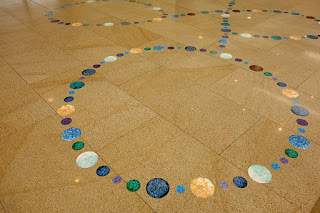Stories retold: Artist-in-Residence
Exhibit
Broad Institute of MIT and Harvard
415 Main Street
Cambridge, MA
April 18 – August 24, 2017
The concept of the passage of time as a
subject for inquiry is at the core of Naoe Suzuki’s exploration in the work
currently on public view in the main lobby at the Broad Institute of MIT and
Harvard. Weaving past and present together, Suzuki contemplates data mining,
knowledge, history, and our belief systems. Stories retold, an
exhibit of selected works completed after being selected as the Broad
Institute’s fifth artist-in-residence (video), reflects her
fascination with, and observation of the scientific community where she has
been immersed since April of 2016.
In the light-filled lobby of the Broad
Institute’s Main Street building, Suzuki has installed nearly 200
brightly-colored decals on the floor and stairs. Close examination reveals that
each circular shape contains images similar to organisms one might observe in a
microscope. The decals snake around to form three circular shapes on the floor,
then trail up the stairs to the mezzanine level.
This site-specific installation, Stories
retold, examines the ancient roots of our belief systems around the
treatment of disease. Suzuki combines and overlays images of magic spells she
traced from a copy of the Edwin Smith papyrus—the oldest medical textbook to
include prognosis in the history of civilization. The papyrus is from ancient
Egypt, 1600 BC, and the spells are written in hieratic, a form of ancient
Egyptian writing. These magic spells were used as medical treatments in the
ancient world. Suzuki traced the magic spells by hand and made them into
drawings first, then she made laser cut versions on vellum paper. Suzuki then
created the “microscopic” views of ancient magic spells by scanning and editing
the laser cut drawings in Photoshop.
The shape on the floor was inspired by the
artistic rendering of the Congo River by Stephen Gire, then a Broad Institute researcher who worked in the Congo during the Ebola outbreak. In that project, Gire digitally rendered the river to form the shape of the Ebola virus in the forest suggesting its ancient origin, which dates back to between 16 and 23 million years ago.
Suzuki contemplates our ancient beliefs about medicine in a time when science, medicine, and technology are all accelerating at a rate that is unprecedented in human history. Bridging together the layers of history, she explores the interconnectedness of meaning between knowledge and belief, bringing forth forgotten beliefs—the magic spells that were mostly written on the verso side of the papyrus—and asks us what is legitimate, what we may have lost, and what we still believe.
On the mezzanine level, a large horizontal
scroll drawing titled, Unapologetic
work of a data parasite and a digital slide presentation, Field
Notes, bring the viewers into the present.
Using as source material the artist’s tracings
of the writings on the whiteboards at the Broad, Suzuki retraced her original
tracings— then enlarged, reduced, repeated and sliced as she saw fit to create
the composition. It was composed in a flow, following the energy that she felt
from the original marks.
 |
| "Unapologetic work of a data parasite" 45"x 216", Mineral pigment, gouache, color pencil, and graphite on paper 2016 |
Field
Notes juxtaposes the scanned images of traced writings from the
whiteboards, which were further edited in Photoshop, with bits of overheard
conversation. The piece subtly critiques the challenges of
data sharing in a scientific community, while shedding light onto scientists’
genuine enthusiasm and joy as well as frustrations. It is composed as “a day in
the life” of a scientist.
“As an artist, the scientists’ challenges and
hard work resonated with me. Most of the time, being an artist or a scientist
involves a lot of hard work. We often occupy uncertain space, trying to figure
out a path to discovery or creation. It is in this dark place where we
struggle, but simultaneously we must feel comfortable being in this place.”
 |
| Still from "Field Notes" |
In all of the work presented at the Broad
Institute, Suzuki’s gesture of tracing seems to honor the original manuscripts
or writings. Her deliberately slow process of transferring these writings is a
meditation on our progress. “Scholars believe that in ancient Egypt when the
Edwin Smith papyrus was written, the same content was copied over many times,
over the span of 200 or 300 years. This means that the methods of diagnosing
and treating patients did not change significantly for a couple of hundred years,”
said Suzuki. “Look at what’s happening now in our time. The sequencing of the
human genome was completed a little over fifteen years ago, and we’re now
talking about precision medicine. Things have been moving at exponential speed
in science, medicine, and technology in the last few decades.”
Suzuki’s artistic practice allows us pause
for a moment in the world where everything seems to be moving fast.
About Naoe Suzuki
Naoe Suzuki is a visual artist based in Waltham, MA. Suzuki received an
MFA from Massachusetts College of Art and Design in 1997. She has been a
recipient of many grants including the Pollock-Krasner Foundation,
Massachusetts Cultural Council, and Berkshire Taconic Community Foundation. Watch the video to
learn more about her project at the Broad Institute.
About the Broad
Institute Artist-in-Residence program
The Broad's artist-in-residence program lies
at the intersection of science and art. The program allows revolutionary
scientists and forward-thinking artists to work, communicate, and learn
together to benefit both science and art, spurring the creative thinking that
drives innovation. Naoe Suzuki is the Institute’s fifth artist-in-residence. Learn more about
their art, their perspectives, and their experience at the Broad.





No comments:
Post a Comment